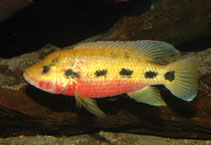| Distribution: |
Africa: widely distributed in West Africa, where it is known from most hydrographic basins, from the Senegal to the Chad basins, including the West African coastal rivers and the middle and lower parts of the Chad basin (Ref. 53405, 123791). Also in the Nile basin (Ref. 5644, 28714) and in the upper Zambezi (Ref. 5644). Distribution of this species and overlap with Hemichromis elongatus unclear, but probably absent from the Congo basin (see also Ref. 43352, 52307, 53405, 81260). Introduced around 1970 in a stream fed by hot springs in Villach (Austria) (Ref. 59043). |
| Diagnosis: |
Dorsal spines (total): 13-15; Dorsal soft rays (total): 11-14; Anal spines: 3-3; Anal soft rays: 8-11. Diagnosis: With 5 dark blotches or cross bars on sides, often alternating with narrower intercalary bars, the first blotch confluent with the opercular spot, the fifth on caudal-fin base; upper profile of snout straight or concave (Ref. 53405). Hemichromis fasciatus can be distinguished from H. elongatus by the small black dots between the first three dark stripes on the flanks of the body of adults in most populations; it can further be distinguished from H. elongatus by a combination of overlapping morphometrics, mainly by: a high number of anal fin soft rays, 8-11 vs. 7-10; number of longitudinal line scales, 29-32 vs. 28-30; number of lower lateral line scales, 10-14 vs. 8-12; a short snout, 27.2-35.2% of head length vs. 27.4-36.4%; short premaxillary pedicel length, 38-49.7% of head length vs. 38.0-51.2%; short head length, 33.1-38.7% of standard length vs. 34.2-40.3%; short predorsal distance, 32.7-39.6% of standard length vs. 34.3-41.3%; short prepectoral distance, 32.9-40.3% of standard length vs. 35.1-42.3%; short prepelvic distance, 35.4-45.3% of standard length vs. 38.2-48.1%; Hemichromis fasciatus is distributed in West Africa while H. elongatus occurs in the southern part of Lower Guinea and the Congo basin in Cameroon (Ref. 123791).
Description: General body shape deep and moderately elongated; dorsal and anal fins reaching or exceeding level of caudal fin origin; dorsal fin straight with a high number of soft rays, soft rays 5 to 6 longest; length of pectoral and pelvic fin rays decreasing from first to last branched rays; caudal fin truncate, subtruncate or rounded; caudal peduncle rather short, slightly deeper than long, its length 11.0-16.0% of standard length; cycloid scales (Ref. 53405, 123791). Head narrow and short, with straight profile, premaxillary pedicel short and generally straight, mouth sub-isognathous to prognathous; premaxilla extremely protrusible; snout of intermediate size, eyes relatively small, cheek with high number of scale rows; lower pharyngeal jaw broader than long, Y-shaped and concave, with 16 to 24 marginal teeth; upper jaw with two rows of teeth (Ref. 53405, 123791). Lower jaw distinctly prominent; outer jaw teeth mixed mono- and bicuspid, inner jaw teeth monocuspid, pharyngeal jaw teeth bicuspid; dentition reduced to an incomplete row of inner teeth in upper jaw; micro-gillrakers present (Ref. 53405). Upper lateral line scales 16-21, lower lateral line scales 10-14, longitudinal line scales 29-32, upper transverse line scales 3-5, lower transverse line scales 8-10, pectoral to pelvic fins range scales 4-6, caudal peduncle rows scales 15-17, cheek scales 5-7 (Ref. 123791).
Colouration: Colour of living specimens: general colour pattern grey-silver to yellow-pinkish, with generally five large vertical dark stripes; scales on flanks marked at edges by a yellowish or silver colour and at the centre and distally by a smaller area of greyish or dark grey-brown colour; small black dots between the first three black stripes present or absent on the flanks of adult fish, absent in juveniles; operculum with a single red opercular spot above the single large black spot; dorsum grey-silverish to yellow intersected by large vertical stripes; belly, chest, neck and chin pink or red; dark lachrymal stripe extending over iris and above the eye; fins grey or yellowish; dorsal fin sometimes with a pink margin while upper caudal fin lobe with incomplete pink margin (Ref. 53405, 123791). Lower part of body orange-red, more pinkish on belly; large, irregular black blotch on upper area of opercle (Ref. 53405). With 4-5 large, black blotches along midline of sides (Ref. 52307, 53405), round to ovoid and sometimes elongated into short vertical bars (Ref. 52307), and 3-5 rows of small black spots in between in specimens over 100 mm SL (Ref. 53405). Vertical fins light grey; soft parts of dorsal and anal fins with basal reticulate pattern; spinous part of dorsal fin bright red; soft part of dorsal and distal part of caudal fins edged with bright red; anterior 1/3 of pelvics blackish, other 2/3 light grey; pectoral fins hyaline (Ref. 53405). Juveniles without orange-red coloration of adults, showing traces of dark intercalary bars; subadults and adults also with dark intercalary bars when under stress (Ref. 53405). Colour of preserved specimens: general body colour yellowish-brown with five large dark blotches or stripes on the flanks; almost invisible in old decolourised type material; large black opercular spot; remnants of red opercular spot invisible (Ref. 123791). |

